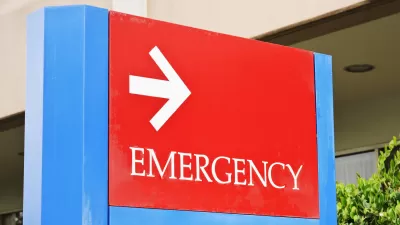Safety
Making Transportation Options Safer for Women
A post by the World Band surveys efforts around the world to mainstream gender on public transport—an effort challenged substantially by continued risks to the safety of women.
How Your House's Garage Induces More Speeding and Less Walking
Throughout North America's auto-oriented suburbs, front-facing garages are a common feature of home design. According to Brent Toderian, that design decision has a significant impact on speeding and the quality of neighborhoods.
Black Friday Ops
When millions of Americans venture forth from their food comas tomorrow to their nearest mall, the shopping environment may have changed from last year. By design, most shoppers are unlikely to notice the increased security measures.
Low Crime Rates In Large Cities Support Multi-Modal Planning and Smart Growth
Contrary to popular assumptions, large, transit-oriented cities have lower crime rates than smaller, automobile-oriented cities. Jane Jacobs was right! This column discusses this phenomenon and its implications for transport and land use planning.
Can Planning Reverse the Rise in Sexual Violence in India's Cities?
The increase in vehicular speeds, removal of street hawkers, and addition of gated neighborhoods are all seen as contributing to a rise in crimes against women in New Delhi and other Indian cities. How can planning and design reverse this trend?
What Happens When a City Turns Out the Lights?
Strapped for cash, cities across the US have decided to save money by turning off street lights. An investigative series documents the effect of all those darkened lights on crime and economic development in San Diego - home to a $30 million backlog.
What Makes a Place Feel Safe?
Utilizing an online tool that compares images from Google Street View, researchers have built a better understanding of the 'small, often imperceptible reasons' that make some streets and places feel safer than others.
Is High-Speed Rail Safe?
For anyone who has ridden in a high-speed train, the idea of a derailment is terrifying. Last week's crash of an Alvia train in Spain made such fears seem less irrational. Yonah Freemark examines whether high-speed rail is a safe mode of travel.

New Study: More Urban = More Safe
A new study by researchers at Children's and the University of Pennsylvania concludes that, contrary to popular perception, cities are safer than rural or suburban areas. Higher rates of fatal car accidents outside cities are largely to blame.
New Report Challenges 'Eyes on the Street' Concept
In the fifty years since Jane Jacobs introduced the "eyes on the street" theory, it's become a commonly accepted conceit that a mix of use reduces crime. A new study calls that theory into question.
Parsing LaHood's Legacy
In the wake of yesterday's surprisingly unsurprising announcement that U.S. Secretary of Transportation Ray LaHood is stepping down, several reporters who focus on transportation issues have taken stock of his tenure.
A Tree Grows in Pigeon Town
I don’t know what it is about New Orleans that makes me wax rhapsodic. But something about the city makes everyday life look poetic. I returned to the Crescent City last week after having last visited just seven months ago, when a tree planting
Probing the False Sense of Security in Gated Communities
Edward Blakely, co-author of “Fortress America: Gated Communities in the United States,” pens an opinion piece for The Washington Post looking at the detrimental psychology that exists in gated communities such as where Trayvon Martin died.
Is a Vibrant City Best Measured at Night?
Chuck Wolfe asks if a city's vitality is best indicated at night, and how it should be measured.
Risk Versus Dread: Implications for Planners; or Let's Not Let The Terrorists Win
“The only thing we have to fear is fear itself—nameless, unreasoning, unjustified terror which paralyzes needed efforts to convert retreat into advance” – President Franklin D. Roosevelt, 1932 This being the decade anniversary of the World Trade Center and Pentagon terrorist attacks, it seems a good time to consider how our society responds to such threats, and what planners can do to maximize safety.
Florida Found Most Dangerous Place for Pedestrians
Four Florida metropolitan areas recently ranked as the most dangerous places for pedestrians, according to a survey by Transportation America.
Security and Walkability Entwine in New Park at White House
Plans to redesign the expanded publicly accessible section of the White House's front lawn combine both walkability concerns and safety concerns.
Bikeable and Walkable, But Room to Improve
Seattle has been named one of the nation's safest p[laces to walk or bike. But some question whether that success will translate into any further improvements in bike and pedestrian infrastructure spending.
Making Safer Streets for Aging Populations
As aging populations grow, more cities and design organizations are looking at how to make streets safer for older residents.
Sidewalks: A Suburban Battleground
Neighbors across the country are clashing over whether or not to build sidewalks in their neighborhoods.
Pagination
Urban Design for Planners 1: Software Tools
This six-course series explores essential urban design concepts using open source software and equips planners with the tools they need to participate fully in the urban design process.
Planning for Universal Design
Learn the tools for implementing Universal Design in planning regulations.
Caltrans
Smith Gee Studio
Institute for Housing and Urban Development Studies (IHS)
City of Grandview
Harvard GSD Executive Education
Toledo-Lucas County Plan Commissions
Salt Lake City
NYU Wagner Graduate School of Public Service


































